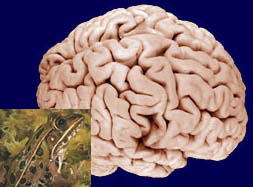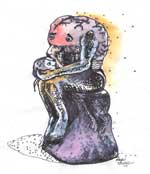Serendip is an independent site partnering with faculty at multiple colleges and universities around the world. Happy exploring!
BBI 2007 Session 2


|
BRAIN AND BEHAVIOR INSTITUTE 2007 |

|
Being a Scientist/Explorer/Creator (Theory):
Living (and Learning/Teaching) in Virtuality
- Science is a tool to help one become better at thinking for oneself, at using observations to make one's own stories that motivate new observations that motivate new stories that one shares with others.
- Science education should help people become better at thinking for themselves at ongoing, shared, exploration and creation
- Scientific statments are "stories", not "reality", since there are multiple interpretations of a given set of observations
Virtuality: the space between the real and the virtual
- Observations are stories too
- There are lots of useful things to learn from the virtual, developing the same skills one would otherwise as well as reaching new understandings
- Students (and teachers) need to develop increased sophistication in working between the real and the virtual ... in virtuality



Comments
virtual games
benefits(?) of tranactionalism in education - bbi07 session 2
7/9/07 pm The ant
I love the ant and the message it seems to be delivering to me-I think I get some of it! It is amazing that a seemingly random pattern can quickly become a pattern, if even for a short amount of time. But in the big picture, I wonder were this is leading to in our discussion of the brain? How are the ant’s behavior and the brain related? I have a feeling in more than one way.
Or is the ant leading us to a nature vs. nurture discussion? Are our genes scripted/programmed to determine behavior and our characteristics? Or does our environment part-take in the process to determine our behavior?Or are we heading to a conversation of the big bang theory? The statement from the Serendip site that “Quite sophisticated behavior can result from simple interactions of simple things” is a fascinating and intriguing one that has massive implications. We will see.
And a final comment on the idea that science is an ongoing story. Brain is a pattern driven processor, it seeks patterns, how it makes sense of the world, it functions on pattern recognition; it is how it sense of the world. For example, everyone in a room feels uncomfortable when a person telling a story/joke misses the punch line to the story/joke. The brain is constantly looking for the closing of the story. It is why good writing start with the main idea followed by supporting details ending with summary/closing paragraph.
Virtuality
the ant and life
Games
Virtuality Response
Afternoon Session, Day 1
virtual and real
Antics
W. Keith Sgrillo I have had
I enjoyed watching Langton's
Lagton's ant could be very
reality vs virtual
real and virtual
Story telling
Post new comment